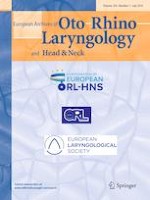Erschienen in:

06.04.2019 | Otology
Facial canal dehiscence in patients with cholesteatoma: concordance between intraoperative inspection, computed tomography and neurophysiological findings
verfasst von:
Francisco Arias-Marzán, Gemma de Lucas-Carmona, Esteban Reinaldo Pacheco Coronel, Pedro Javier Perez Lorensu, Alejandro Jiménez-Sosa, Blas Pérez-Piñero
Erschienen in:
European Archives of Oto-Rhino-Laryngology
|
Ausgabe 7/2019
Einloggen, um Zugang zu erhalten
Abstract
Objectives
To assess the diagnostic capacity of intraoperative neurophysiological monitoring with respect to “gold standard” microscopic findings of facial canal dehiscence in middle ear cholesteatoma surgery.
Study design, patients and setting
We carried out a retrospective cohort study of 57 surgical interventions for cholesteatoma between 2008 and 2013 at Hospital Universitario de Canarias, Spain.
Diagnostic interventions
Each patient underwent preoperative computed tomography (CT), intraoperative neurophysiological monitoring and intraoperative inspection of the facial nerve during microsurgery. Diagnostic concordance on the presence/absence of facial canal dehiscence was assessed in 54 surgical interventions.
Main outcome
Presence of facial canal dehiscence.
Results
Of 57 interventions, 39 were primary surgeries; 11 (28.2%) showed facial canal dehiscence. and 18 were revision surgeries; 6 (33.3%) showed facial canal dehiscence. The facial nerve was not damaged in any patient. Facial canal dehiscence was observed in 17 (29.82%) interventions. We used intraoperative microscopic findings as the gold standard. Neurophysiological study showed a sensitivity of 94.1, specificity 97.3, positive predictive value (PPV) 57.8 and negative predictive value of 97.2. CT showed a sensitivity of 64.7, specificity 78.4, PPV 57.8 and negative predictive value of 82.
Conclusions
Our neurophysiological study showed greater sensitivity and higher PPV than CT for the detection of facial canal dehiscence. We found no relationship between disease progression time and the presence of facial canal dehiscence.











